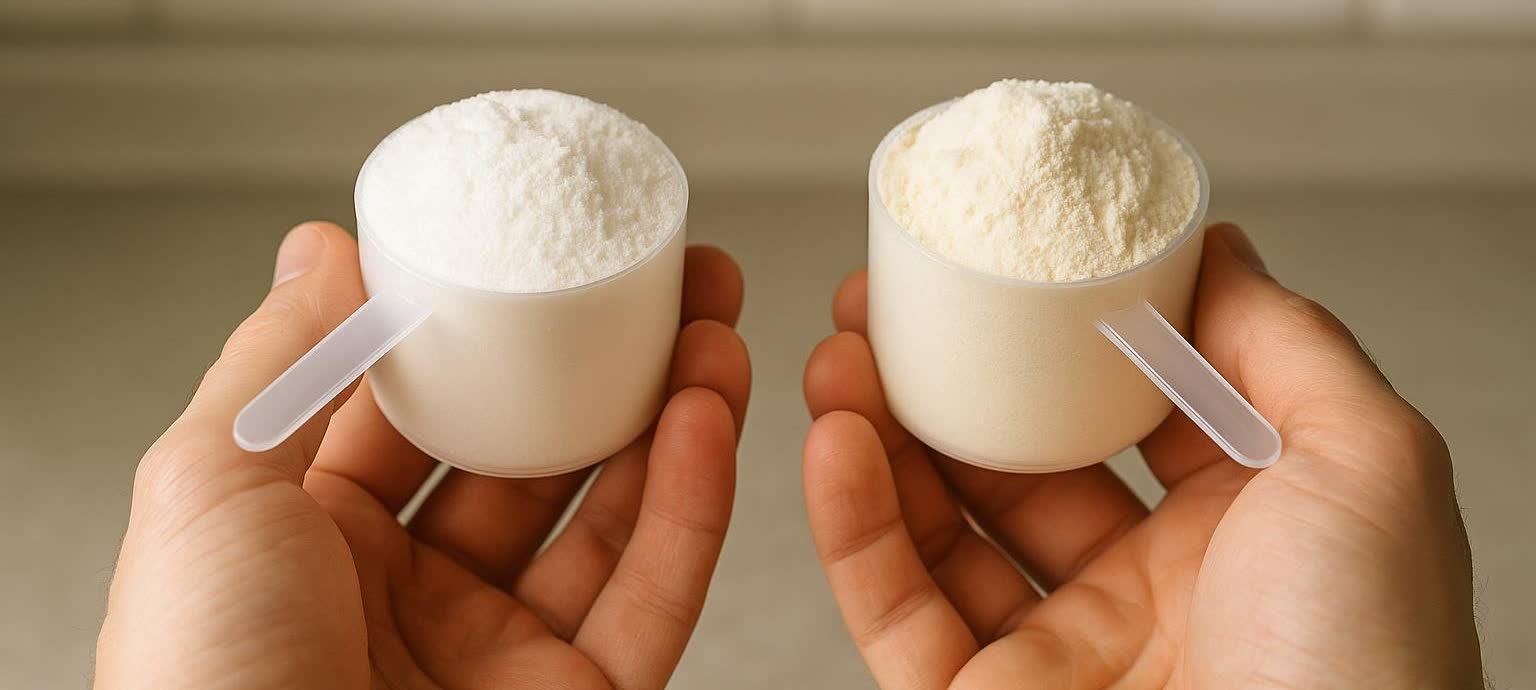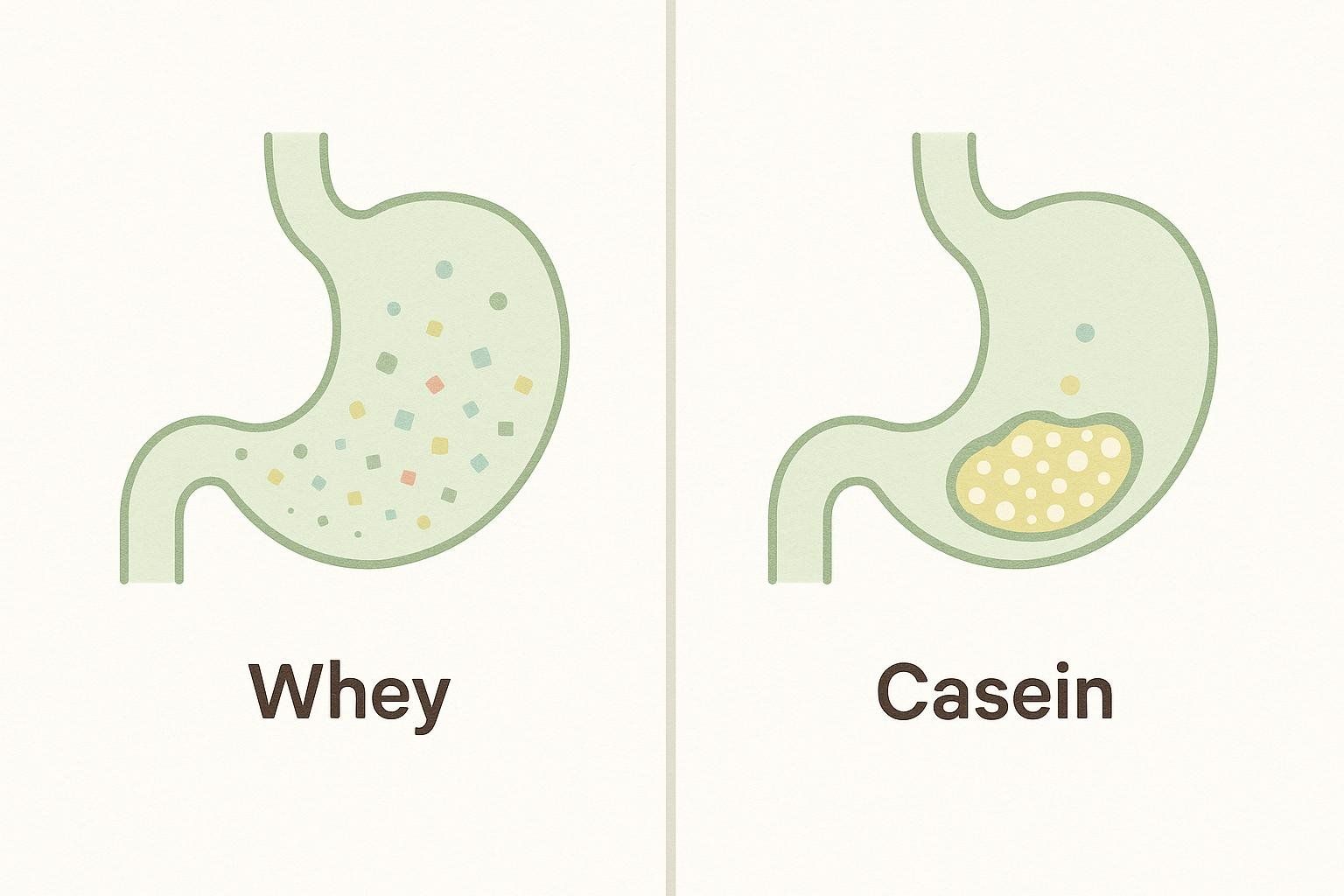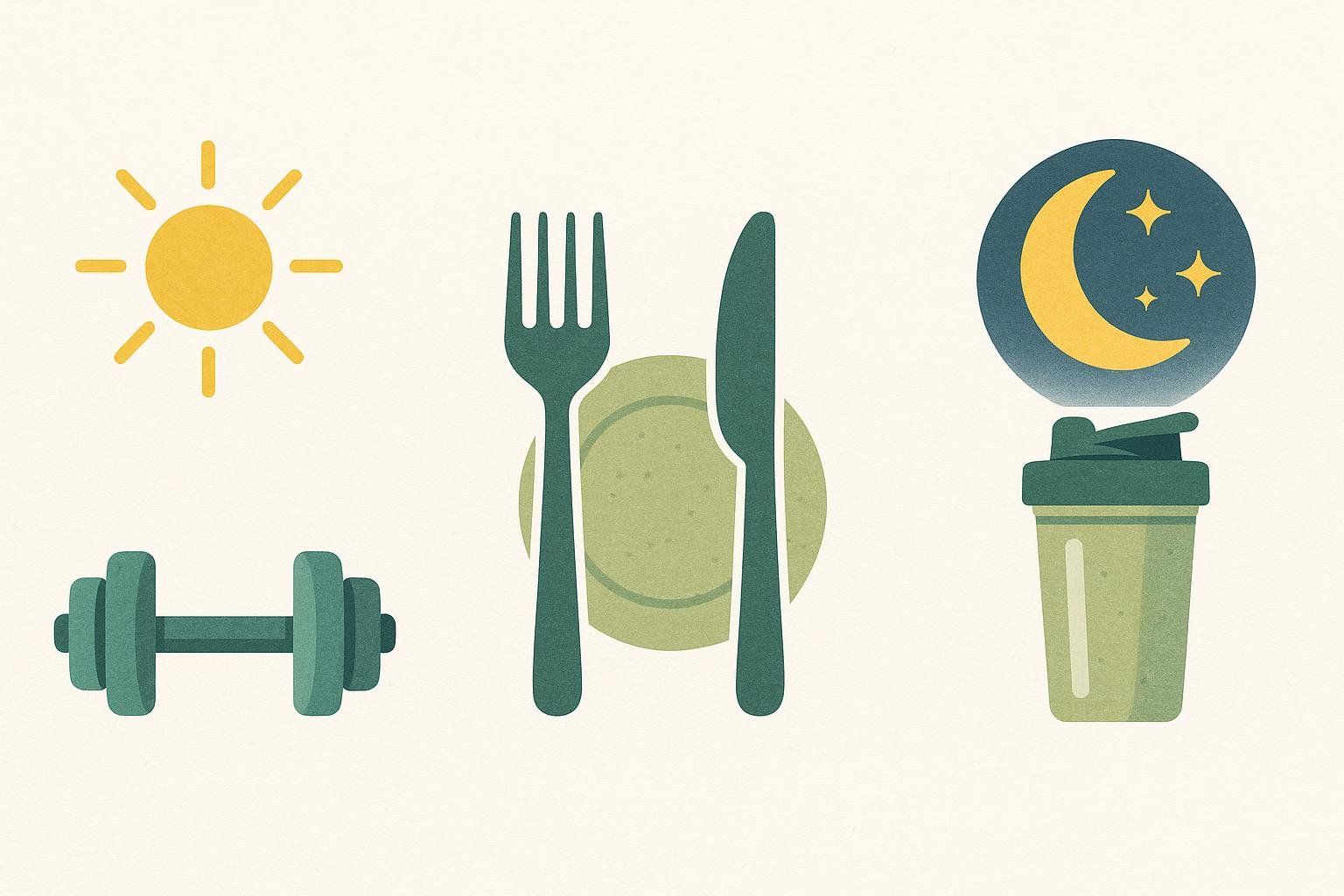Whey vs. Casein: Which Protein Powder Fits Your Goals?

Whey vs. Casein: Which Protein Powder Fits Your Goals?
If you lift, cut, or simply want more protein with minimal prep, you’ve likely run into the big question: fast‑digesting whey or slow‑release casein? Which is right for you—and when?
- Post‑workout: Choose whey for a fast amino acid surge and easy mixing.
- Before bed or long gaps: Casein is often recommended because it releases slowly—but after evening workouts, recent research suggests either whey or casein can work pre‑sleep.
- Big picture: Both can build muscle if your total daily protein is on point, a conclusion supported by both Healthline and WebMD.
Whey vs. Casein at a glance
| Feature | Whey | Casein |
|---|---|---|
| Source | Milk (≈20% of milk protein) | Milk (≈80% of milk protein) (Cleveland Clinic) |
| Digestion kinetics | Fast; blood amino acids peak within ~60–90 min (Healthline) | Slow; forms a gel in the stomach with a steadier release over several hours (Cleveland Clinic; Healthline) |
| Typical use case | Post‑workout or when you’ll eat again soon | Pre‑sleep or during long gaps between meals |
| Leucine impact | Higher immediate leucine rise (triggers MPS) | Lower spike, sustained release |
| Satiety feel | Lighter mouthfeel; mixes easily | Thicker; many find it more filling (WebMD) |
| Lactose considerations | Isolate: very low lactose; concentrate: more | Contains lactose; avoid with milk protein allergy |
| Cost/texture | Generally cheaper; mixes thin | Often pricier; mixes thicker/clump‑prone (WebMD) |

Muscle growth and recovery: What the evidence really says

- Fast vs. slow isn’t a winner‑take‑all. Whey’s quick leucine spike supports post‑workout muscle protein synthesis; casein’s slow release helps keep you covered between meals or overnight (as explained by Healthline and the Cleveland Clinic).
- Equal protein + equal training ≈ similar results. An 8‑week supervised study on female NCAA basketball players found no significant differences between whey and casein for DXA body composition, strength, or performance when taken pre‑ and post‑workout (according to a 2013 study on female athletes).
- Pre‑sleep protein works—and type may not matter much. After evening exercise, a controlled trial showed that 45 g of whey or casein before sleep similarly increased overnight myofibrillar and mitochondrial protein synthesis versus placebo (as reported in a Nutrients, 2023 study). A broader synthesis concluded that pre‑sleep protein is digested and absorbed and can aid gains, especially alongside training (summarized in a Frontiers in Nutrition review, 2019).

Practical takeaways
- If you’ll eat a full meal within ~1–2 hours, either whey or casein works—hit your total daily protein first.
- Training twice in a day? Use whey post‑workout for speed, then prioritize whole‑food protein later.
- Struggle to eat enough before bed or wake up hungry? Casein (30–45 g) is a convenient “slow” option.
- For a broader recovery framework (sleep, carbs, hydration), see our guide to Muscle Recovery.
Satiety and weight management
Research and real‑world experience don’t always line up perfectly—and that’s okay. Here’s what we know:
- A 12‑week randomized trial in adults with overweight or obesity reported that whey produced higher pre‑meal satiety and fullness scores than casein at weeks 6 and 12, but this did not lead to lower calorie intake or weight loss (Pal et al., 2014).
- Many people still report that casein “sticks” with them longer, likely because it forms a gel and digests slowly (noted by WebMD and the Cleveland Clinic).
- A systematic review found limited or mixed effects of pre‑sleep casein on next‑morning appetite and metabolism in healthy adults—it’s useful for protein distribution, but not a magic satiety hack (Nutrients, 2021 review).
The takeaway: pick the option that helps you feel satisfied and stick to your calories. Ultimately, total daily protein and calorie balance drive fat loss. For objective tracking, lean on body‑composition data over the scale alone—see our Body Recomposition 101.
Tolerance, lactose, and allergies: What to know before you buy

- Lactose intolerance: Whey isolate typically contains very little lactose, whereas whey concentrate and casein powders can have more (as explained in a Healthline guide). People with lactose intolerance also often tolerate small doses better with meals, according to a comprehensive review (Nutrients, 2018 review).
- Milk/casein allergy: Avoid casein—and often whey—if you have a diagnosed milk protein allergy; discuss alternatives with your clinician (guidance from the Cleveland Clinic).
- GI comfort: Whey mixes thinner and tends to sit lighter; casein is thicker and more filling (as echoed by WebMD). Trial small servings first.
How to choose by goal (quick guide)
- I want muscle fast and train most days
Consider: Whey post‑workout (20–40 g). Add whole‑food protein at meals. Optional casein 30–45 g pre‑sleep if you miss protein targets. - I’m cutting and need fewer cravings
Consider: The one you enjoy and adhere to. Whey may curb appetite acutely; casein often feels more sustaining over hours. Keep protein ~1.6–2.2 g/kg/day and track results objectively with body‑composition data. - I’m lactose intolerant
Consider: Whey isolate, plant proteins, or lactose‑free dairy proteins. Start low, test tolerance; pair with meals. - I coach clients and need a neutral, evidence‑based stance
Consider: Reinforcing that both work. Match the protein to timing, appetite, and tolerance; insist on third‑party testing for purity.
Dosing, timing, and everyday use

- Daily protein target: Most active adults do well with ~1.6–2.2 g/kg/day from food + supplements, as outlined in our macro tracking guide and The Protein Primer. Spread intake across 3–5 meals.
- Post‑workout: 20–40 g whey or casein if a meal isn’t imminent. Prioritize total daily intake over stopwatch timing.
- Pre‑sleep: When you’ve trained in the evening, 30–45 g of whey or casein before bed can boost overnight muscle protein synthesis; recent work suggests the specific type may not matter (as shown in a Nutrients, 2023 study and a Frontiers in Nutrition review, 2019).
- Double sessions or hard blocks: Use whey for convenience and faster gastric emptying; add casein at night if it helps you reach your daily protein.
Want help nailing macros and meal timing? Start with our list of High‑Protein, Low‑Carb Foods.
Supplement quality checklist (save this)
Before you add any tub to cart, look for:
- Third‑party testing: NSF Certified for Sport, Informed Choice/Sport, USP verification.
- Transparent label: Clearly lists protein type (whey isolate vs. concentrate; micellar casein), serving protein grams, and amino profile.
- Sensible sweeteners and sodium; minimal fillers.
- Allergen disclosure and manufacturing practices.
What about blends (whey + casein)?

Blends aim to pair a quick amino surge with a longer tail. They’re a handy all‑in‑one option if you want one tub for both post‑workout and pre‑sleep. Trade‑off: you have less control over timing and texture than keeping separate whey and casein on hand, and cost per serving can be higher. As always, results come from the fundamentals—consistent training, enough daily protein, and a plan you’ll stick to.
Track results with data, not guesses
Ultimately, the whey vs. casein debate is secondary to what you can do consistently. Instead of guessing, track your results with objective data. A BodySpec DEXA scan quantifies lean mass, fat mass, and visceral fat so you can see if your protein strategy is preserving or adding muscle while you cut.
FAQ
Is casein “better” before bed?
Not necessarily. After evening workouts, both whey and casein similarly increase overnight muscle protein synthesis. Choose the one you tolerate and enjoy.
Which is better for weight loss: whey or casein?
Neither wins outright. Whey may deliver stronger short‑term satiety in some studies; casein often feels more sustaining over hours. Bottom line: calorie balance and total protein drive fat loss.
I’m lactose intolerant—what can I use?
Whey isolate is typically low in lactose, and many people tolerate small lactose doses better with meals. Prefer dairy‑free? Try soy or pea blends. If symptoms continue, check with your clinician.
Can I just use whole foods?
Absolutely. Powders are for convenience. Aim for high‑quality protein across meals; supplement to fill gaps. See our list of High‑Protein, Low‑Carb Foods.


